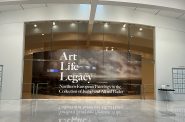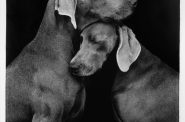Current Tendencies and There, There
We’re heading into a transitional time in the Milwaukee art calendar with exhibitions opening and closing. Two shows that end this week, but are definitely worth checking out, are Current Tendencies: Ten Artists from Wisconsin at the Haggerty Museum of Art and There There at the Peck School’s Inova/Kenilworth gallery.
These exhibitions are a bit like cross-town cousins; common traits link them in the family, but they each have distinctly individual characters. Current Tendencies is calm, composed, strait-laced and solid. There There is the wily one, admittedly more playful and mischevious, the prankster of the two. Both are affiliated with major universities in the city and offer up contemporary work from an array of artists.
Current Tendencies – The Haggerty
Current Tendencies purports to look at trends in Wisconsin art. But don’t let that conjure up images of farmland, cows and the Fonz – none of that to be found here. In fact, there is nothing in image or commentary that is specific to Wisconsin at all. Moreover, most of the artists are not native to the state, but are practicing here now. It’s a show that presents some current trends, but nothing definitive in major movements, styles, or issues. Diversity in message and practice is the prevailing tendency.
Colin Matthes, Proposal for Winners Circle, 2009. Ink and paint on paper. Courtesy of the artist
The show opens with Colin Matthes’ Winners Circle. Matthes, whose work was on view at Inova/Kenilworth last fall in conjunction with the Mary L. Nohl Fund Fellowship awards, presents us with desolate spectators looking in on a carnival game with a brightly painted wheel-of-fortune apparatus, ready to be spun by a slinky sideshow version of Fortuna. Let us see what surprises await.
T. L. Solien, Storm of Imperfections, 2004. Oil on canvas. 78 x 96″. Courtesy of T. L. Solien and Tory Folliard Gallery
Painting looms large in the work of T. L. Solien. His canvases take a number of influences: cubist plays of space that scoot from two-dimensions to three-dimensions and back, surrealistic flotsam and jetsam, even anime-like girls with big eyes and varying dispositions, wrapped up with delicious black spaghetti lines. The surface is an engaging cacophony, but the composition is all control; neat around the edges, our attention circles within the center.
The aesthetics of surface are of prime importance in the work of Peter Bardy, a recently discovered (and unfortunately recently deceased) Milwaukee artist. His work takes on found objects and reclaimed materials, especially those of the industrial persuasion. Minimalism takes on an alternative form as cast-offs are reframed for the visual properties that Bardy leads us to see.
Anne Kingsbury, Beaded Journal Page (detail), 2000. Leather and beads. 16 x 12″. Collection of the artist
Art intersects with everyday life in the work of Anne Kingsbury. Her Journal Pages span the late 1970s to the2000s, and the pieces in the show freely combine word and image to document ordinary tasks of living – showering, laundry, tidying up and more. Ah, but it’s not just these activities; it’s the time, too, as the minutes for each chore are dutifully recorded. For all of us pummeled and prodded by our CrackBerries and Google calendars, this can put into physical form the terror of minutes and hours and days handed over from our lives to domestic necessities, but it also gives some comfort, a sense of kindred spirit in the inevitability of household duties. Details, details.
Details of an entirely different sort take up our attention in Jennifer Angus’s A Worm’s Eye View. Angus, whose installations have also appeared at the John Michael Kohler Arts Center, investigates the intricacies of decoration, design and nature in a very literal sense. Walls of the gallery are covered with lovely printed wallpaper and hundreds of insect specimens carefully pinned into elaborate, elegant patterns.
The exhibition is rounded out with the photography of Sonja Thomsen and the paper cutouts of Xiaohong Zhang. Visually wandering through the small-scale photos of people in Thomsen’s Lacuna is a bit like trying to eavesdrop at a party, picking up a snippet of dialogue there, a fragment of character there, but with a sense of futility in the blank spaces, the things that won’t be known or filled in, the void between truth and imagination. Zhang’s paper cutouts take on imagination of a different kind, that of cultures and history and identity. Her work uses traditional art form to address elements of cultural crosscurrents and imperialism, both in historical events (The Rape of Nanking, 2007) and contemporary living (New American Zodiac, 2007-2008).
Before departing, there is one other installation to see. It’s not in the gallery, not outside; it’s in that liminal space known as the entrance. When you’re in the vestibule, look up and you’ll find Lost in Transit by Shana McCaw and Brent Budsberg. Unfortunately, the space seems to work against the delicate sensibilities intended for this piece, those of playing with perception and the recreation of events. The setting is intriguing, but ultimately confusing. McCaw and Budsberg, as installation artists, have a deftly elegant touch, as exemplified in their fascinating recent pieces at the now-defunct Armoury Gallery. But here, setting and situation upset the balance for Lost in Transit.
There There at Inova/Kenilworth
There There at Inova/Kenilworth is an odd little mélange of things, all sorts of shapes and forms and suggestions. Something in the placement and curatorial acumen of this arrangement brings to mind the childlike delight of discovery. But, you have to be ready for it. Go in, but don’t worry about “what is it?” It becomes clearer as you wander along. Patience.
This group show, featuring six artists from Milwaukee, Chicago, New York and San Francisco, jumbles everything together in a playful integration of space and visual dialogue between works. The curatorial staff does away with pesky wall text, but there are laminated gallery guides available with names, titles and other vital statistics. At first the arrangement can feel chaotic as you try to discern who’s who and where they are, but given time you’ll start to recognize things, and find out where you are.
Nancy Ford, Untitled, 2008. Acrylic and enamel on papier mache
Small sculptures by Nancy Ford are scattered on the floor, looking sweet and desolate, like tiny brightly colored structures that have fallen and collapsed upon themselves, but they refuse to give up. They sit like miniature deconstructivist buildings, charming in their petite nature and stalwart attitudes.
A sort of determination also seems to emanate from the sculptures of Sarah Brahman, composed of eclectic objects including plastic and a Goodwill-quality painting. A signature element seems to be a slash of spray paint crossing her works, rather like a threat of condemnation hanging over the decrepit materials. They persist anyway, like squatters in a boarded-up house. Elegiac, but plucky.
Joe Bradley, Neil, 2008. Grease pencil on canvas
Joe Bradley’s works on fabric also strike a somber tone, but it’s the silence of economy. Spare lines, a few dark marks, the residue of dust and grime on coarse, pale cloth with loose and fraying ends are a counterpoint to the bright timbres of most of the other works in the show. Natural in a casual way, despite the abuse of exposure and dirt.
The paintings of Scott Reeder appear to be bluntly simple on the surface, with titles that smile, nod, and give nothing away. He paints Swiss cheese, and hangs it on the wall. But this isn’t some traditional old still life of Swiss cheese; it’s two large canvases shaped like Swiss cheese in their entirety, holes and all. And this is where it gets tricky. Notice the wavy contours of the canvas, the idiosyncratic holes in the middle, the edges carefully attended to, secured and turned down. It calls to mind Frank Stella, an American painter of the 1960s associated with post-painterly abstraction and minimalism – shapes of sharply clear colors organized on canvases of weird and irregular geometries. Reeder’s works seems something of a reiteration of this, with cheese. And stones. And a sleeping bag.
Yes, yes, of course, smile and chortle. There’s plenty in this show that is visual punnery; it’s not an exhibition with an axe to grind or grand message to proclaim. But not everything has to thump us over the head with self-importance. It can simply poke us in the arm and grin.
Jefferson Pinder, Anthology
A trip to Inova/Kenilworth this week also offers a significant bonus. Jefferson Pinder’s Anthology will close on Sunday, June 14. Pinder is based in Washington, D.C., and the collection of his video works offer a hypnotic and provocative viewing experience in identity, physicality, and culture through striking cinematography.
Art
-
Exhibit Tells Story of Vietnam War Resistors in the Military
 Mar 29th, 2024 by Bill Christofferson
Mar 29th, 2024 by Bill Christofferson
-
See Art Museum’s New Exhibit, ‘Portrait of the Collector’
 Sep 28th, 2023 by Sophie Bolich
Sep 28th, 2023 by Sophie Bolich
-
100 Years Of Memorable Photography
 Sep 18th, 2023 by Rose Balistreri
Sep 18th, 2023 by Rose Balistreri





















